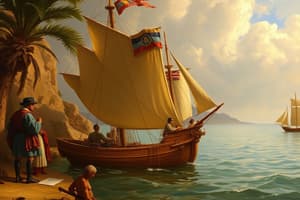Podcast
Questions and Answers
What significant invention did Johannes Gutenberg create around 1450?
What significant invention did Johannes Gutenberg create around 1450?
- First Printing Press (correct)
- Typewriter
- Telegraph
- Photocopier
Which new technology greatly improved sea navigation during the exploration period?
Which new technology greatly improved sea navigation during the exploration period?
- Fishing trawler
- Steamship
- Caravel with lateen sail (correct)
- Sailing ship with square sails
What was one of the major impacts of the printing press by the year 1500?
What was one of the major impacts of the printing press by the year 1500?
- Reduction in literacy rates
- Decline in bookshops
- Increase in handwritten manuscripts
- Standardization of texts (correct)
Who rounded the Cape of Good Hope in 1487, establishing a crucial sea route?
Who rounded the Cape of Good Hope in 1487, establishing a crucial sea route?
Which factor contributed to the massive decline of indigenous populations in the Americas?
Which factor contributed to the massive decline of indigenous populations in the Americas?
What were the primary reasons for early exploration as indicated by the 3Gs?
What were the primary reasons for early exploration as indicated by the 3Gs?
What was the significance of the Treaty of Tordesillas in 1494?
What was the significance of the Treaty of Tordesillas in 1494?
What was one of the economic motivations for Portuguese exploration?
What was one of the economic motivations for Portuguese exploration?
Which of the following was a consequence of European colonization in the Americas?
Which of the following was a consequence of European colonization in the Americas?
What was a notable success of Vasco da Gama's 1498 voyage?
What was a notable success of Vasco da Gama's 1498 voyage?
Flashcards
Printing Press Invention
Printing Press Invention
The invention of the printing press in Mainz, Germany, around 1450 revolutionized the spread of knowledge. It used movable type and a wooden hand press to create copies of books efficiently. Johannes Gutenberg is credited with this groundbreaking invention.
Impact of Printing Press
Impact of Printing Press
The printing press led to a surge in the production of books, expanding literacy and access to information among the wealthy. It also created new jobs like librarian, bookseller, and publisher, contributing to a growing knowledge-based society.
Caravel Ship
Caravel Ship
The Caravel, a lighter and faster ship with a lateen sail, revolutionized seafaring in the 15th century. Its ability to sail into the wind enabled longer voyages and exploration, paving the way for European discoveries.
Conquistadors
Conquistadors
Signup and view all the flashcards
Silver Discovery
Silver Discovery
Signup and view all the flashcards
What were the main motivations for European exploration in the 15th and 16th centuries?
What were the main motivations for European exploration in the 15th and 16th centuries?
Signup and view all the flashcards
What was the Treaty of Tordesillas?
What was the Treaty of Tordesillas?
Signup and view all the flashcards
What is the Columbian Exchange?
What is the Columbian Exchange?
Signup and view all the flashcards
Who were the Spanish Conquistadors?
Who were the Spanish Conquistadors?
Signup and view all the flashcards
How did European diseases affect the indigenous populations of the Americas?
How did European diseases affect the indigenous populations of the Americas?
Signup and view all the flashcards
Study Notes
European Exploration and Conquest
- European powers explored and conquered the Americas, driven by motivations like spreading Christianity (God), acquiring wealth (Gold), and achieving glory (Glory).
- The desire to bypass Venetian trade monopolies for Asian goods also fueled exploration.
- Christopher Columbus's voyages in 1492 led to the encounter between Europeans and the Americas.
- The Treaty of Tordesillas (1494) divided the newly discovered lands between Spain and Portugal.
- Portugal focused on coastal regions of Africa and Asia.
- Spain focused on the Americas, conquering territories and establishing colonies.
- Vasco da Gama reached India by sea in 1498, dominating spice trade.
- Balboa crossed the Isthmus of Panama and sighted the Pacific Ocean.
- Cortes conquered the Aztec Empire in Mexico.
- Pizarro conquered the Inca Empire in Peru.
- The Columbian Exchange involved the transfer of plants, animals, and diseases between the Old World and the New World.
- Diseases like smallpox, measles, and typhus devastated indigenous populations in the Americas.
- European populations in the Americas increased dramatically.
- The Spanish established major silver mines in Mexico and Peru, enriching the Spanish crown tremendously.
- Portugal prioritized trade, establishing a vast network of trading posts.
- New technologies like caravel ships with lateen sails facilitated overseas voyages.
- European expansion led to significant population losses in the Americas and reshaped global trade and power dynamics.
Printing Press
- Johannes Gutenberg invented a movable type printing press in Mainz (Germany) around1450.
- The printing press allowed for the mass production of books, significantly increasing literacy rates.
- Cosimo de Medici funded the creation of many volumes.
- Books became more accessible to a wider audience, facilitating the spread of knowledge and ideas.
- Increased literacy rates among the elite and in towns, a far cry from the masses (3-4% initially).
- By 1500, approximately 35,000 books were produced annually; by 1600, this increased to 150,000–200,000.
Exploration Motives
- The primary motivations were "God, Gold, and Glory."
- God represented spreading Christianity and converting indigenous peoples.
- Gold represented wealth from resources and trade.
- Glory represented personal and national honor.
Studying That Suits You
Use AI to generate personalized quizzes and flashcards to suit your learning preferences.




